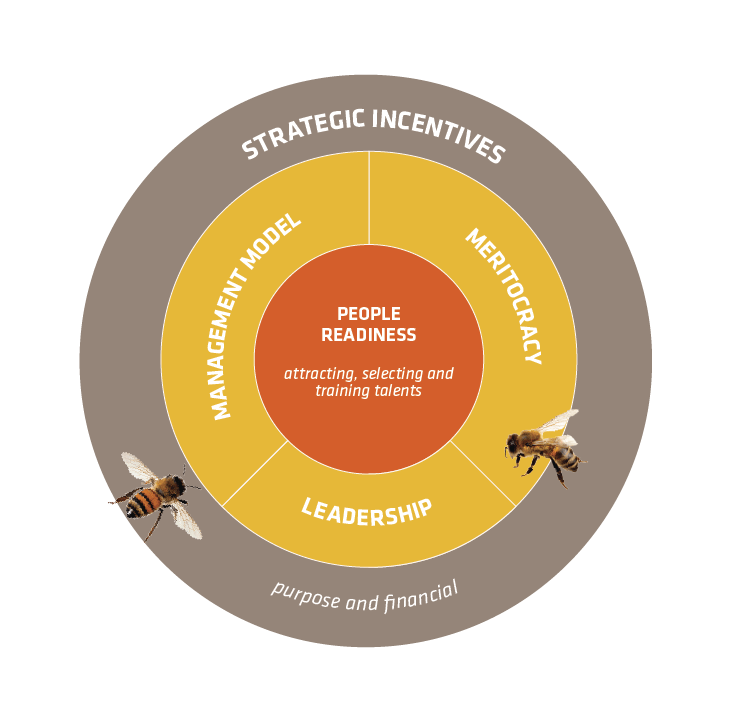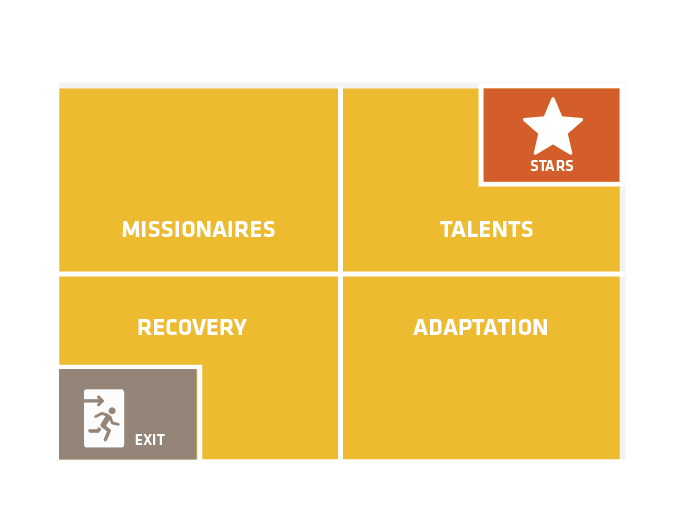How do you make changing HR paradigm take off? Learn the key points in recruiting and keeping the right people in the company
The Human Resources (HR) sector has undergone great changes throughout the years, from the time in which its role was only to execute the accounting records of employees, to its strategic phase, where it began its phase focusing on market positioning and it continues to this day, centred on people.
The People and Management model emerged seeking to elevate HR to a new strategic level, through the combination of the Management Model with Talent Management practices.
A result of this scenario, the People and Management model emerged seeking to elevate HR to a new strategic level. Through the combination of the Management Model with Talent Management practices, implementing the “People-Centred Strategy” through 5 blocks: People Readiness, Strategic Incentives, Management Model, Meritocracy, and Leadership.


People Readiness
The People Readiness block is the basis of the People and Management model, because people are the main asset of an organisation. They are the ones who promote actions and give purpose to the organisations. Therefore, in order to ensure that hired professionals have the necessary profile to effectively contribute to the achievement of the company’s mission and are aligned with the organisational culture, the leadership must actively participate in the processes of attracting and selecting talents. In addition, training and development programs are essential for these talents to achieve the company’s strategic plans. The People and Management model also encourages the practice of internal recruiting for leadership positions, given that you can make better use of the organisation’s human capital potential and guarantee people with well-developed organisational values and culture.
Strategic Incentives
Aiming to encourage and retain talents, the People and Management model offers strategic incentives to employees. Strategic incentives help establish the organisation’s culture and atmosphere, to the extent that, by being developed and managed, they encourage and reward alignment with the company’s mission and values. For the implementation of these incentives to be successful, it is necessary for them to be linked to individual targets and those of the organisation. These incentives can be financial, such as a Bonus, Profit Sharing, and Stock Options, as well as non-financial factors, which are those related to establishing job meaning and defining greater purpose of the company.
Management Model
To structure the management model, it is necessary to first, carry out the strategic alignment of the organisation, by defining the big dream and values, and later SWOT analysis to define strategies. This should be followed by the breakdown of the company’s targets, defined through: the budget, strategic projects, and the aspects of Profitability, Longevity, and Cash. Once defined, the targets must be assigned from upper management to the lowest of the hierarchical teams and then, monitored through routine management and project management, always seeking for continuous improvement.
Meritocracy
It can be said that meritocracy is a management model based on merit, in which promotions and other rewards are obtained by those who present the best results. In order to implement a meritocratic system, a career and salary plan, in which the skills and expectations of each position are defined, as well as the remuneration for each level and possible career paths for each professional profile must be structured first. Next, it is important to implement a performance appraisal model, such as the 9 boxes model, which evaluates potential and performance in 9 boxes, or the 6 boxes model, which evaluates adherence to culture (values) and performance (delivery) and classifies employees into 6 boxes. After the evaluation cycle is complete, they will serve as the basis for rewarding employees, either through promotions or through another form of reward, and for providing them with formal feedback.
Learn more: 6 Boxes Model
6 Boxes model evaluates employees in the spheres of performance and adherence to the company’s culture (values). According to this evaluation, employees are positioned in one of the boxes.
The boxes in this framework have a slightly different division from others: it is first divided equally into 4 boxes. Then, 2 smaller boxes are formed in 2 opposing corners. In this way, the 6 boxes model shows the following boxes, according to the figure blow:


– Recovery: These are people who, in addition to not delivering what was expected on time and not meeting targets, they have low adherence to the values of the organisation.
– Missionaries: These are people who, despite not delivering what was expected, have high adherence to the culture of the organisation.
– Adaptation: Also called “Mercenaries”, these are people who deliver a lot, i.e., exceed their targets, but do not adhere to the company’s culture.
– Talents: These are people who, as the box says,, are the company’s talents, i.e., these are people who in addition to performing well and providing good results for the company, have high adherence to the company’s values. These are the people the company should not lose.
– Exit: These people were poorly evaluated, have no expectations, and are subject to dismissal.
– Stars: These are people who perform and adhere to the culture above all expectations and should in no way be allowed to leave the company. On the contrary, they should remain and grow further and serve as an example to motivate others.
Leadership
A leader is responsible for achieving the desired results and strategic goals of the organisation through the involvement of their team, as well as being an incentive for the employee’s growth and disseminating the organisational culture. They should have distinct values and attitudes, based on the determination for results associated with self-denial, modesty, not accepting zones of comfort for their team or for themselves, leadership by example and with the mindset of “thinking like an owner”.
Thus, the People and Management model ensures the attraction, development, and retention of good people aligned with efficient management of the strategic guidelines day to day, being the path to success for good results.
About the authors
Janaina Jacobs is a Visagio consultant, specialising in projects focusing on process engineering, organisational transformation, and implementation of a shared services centre in the real estate, retail, healthcare, finance, and telecommunications sectors.
Marcela Figueiredo is a Visagio consultant, specialising in projects focusing on management models, organisational transformation, and process reengineering in retail, financial markets, and public management, among others.


